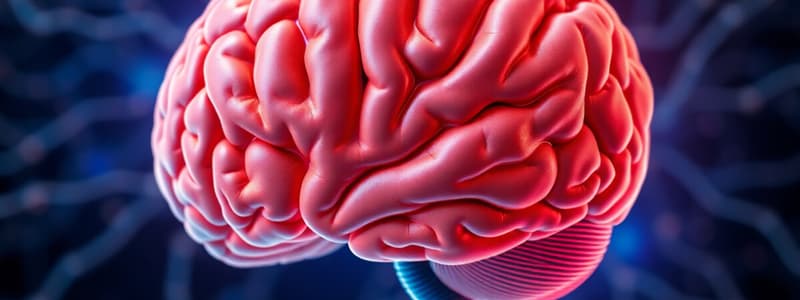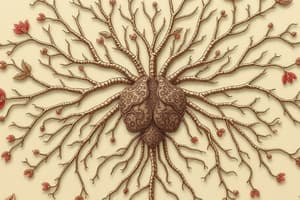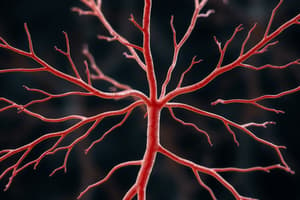Podcast
Questions and Answers
Which neurobiologic theory aligns with logical reasoning and analytical functions?
Which neurobiologic theory aligns with logical reasoning and analytical functions?
- Cerebellum
- Brain stem
- Left hemisphere
- Right hemisphere (correct)
What structure connects the two hemispheres of the brain, facilitating coordination?
What structure connects the two hemispheres of the brain, facilitating coordination?
- Corpus callosum (correct)
- Pituitary gland
- Amygdala
- Pineal body
Which of the following functions is primarily controlled by the frontal lobe?
Which of the following functions is primarily controlled by the frontal lobe?
- Regulating memory and smell
- Interpreting sensations of touch
- Coordinating visual inputs
- Moral behavior and body movement (correct)
A patient has difficulty with spatial orientation and interpreting sensations. Which lobe is most likely affected?
A patient has difficulty with spatial orientation and interpreting sensations. Which lobe is most likely affected?
Damage to which lobe would most likely result in impaired hearing and memory?
Damage to which lobe would most likely result in impaired hearing and memory?
Which part of the brain stem is responsible for vital functions such as respiration and cardiovascular function?
Which part of the brain stem is responsible for vital functions such as respiration and cardiovascular function?
If a patient exhibits impaired motor activity, altered sleep patterns, and changes in consciousness, which system is most likely affected?
If a patient exhibits impaired motor activity, altered sleep patterns, and changes in consciousness, which system is most likely affected?
What is the primary function of the thalamus within the limbic system?
What is the primary function of the thalamus within the limbic system?
Which structure of the limbic system is most associated with the regulation of temperature, appetite, and endocrine functions?
Which structure of the limbic system is most associated with the regulation of temperature, appetite, and endocrine functions?
Which of the following mental disorders has disturbances in the limbic system been implicated?
Which of the following mental disorders has disturbances in the limbic system been implicated?
Which brain imaging technique uses radioactive tracers injected into the bloodstream to monitor brain activity?
Which brain imaging technique uses radioactive tracers injected into the bloodstream to monitor brain activity?
What information does a CT scan primarily provide about the brain?
What information does a CT scan primarily provide about the brain?
What is a key limitation of using PET and SPECT scans for brain imaging?
What is a key limitation of using PET and SPECT scans for brain imaging?
Abnormal neurotransmission can cause mental disorders due to what?
Abnormal neurotransmission can cause mental disorders due to what?
Which neurotransmitter is directly associated with behavior, cognition, attention, learning, and memory processes?
Which neurotransmitter is directly associated with behavior, cognition, attention, learning, and memory processes?
Which neurotransmitter system is heavily involved in the modulation of psychomotor functioning?
Which neurotransmitter system is heavily involved in the modulation of psychomotor functioning?
Which neurotransmitter is primarily responsible for the regulation of complex movements, coordination, and emotions?
Which neurotransmitter is primarily responsible for the regulation of complex movements, coordination, and emotions?
An increase in dopamine activity is most likely associated with which of the following conditions?
An increase in dopamine activity is most likely associated with which of the following conditions?
What condition is most likely associated with decreased levels of serotonin?
What condition is most likely associated with decreased levels of serotonin?
Which neurotransmitter is primarily involved in the regulation of sleep, especially the onset of sleep?
Which neurotransmitter is primarily involved in the regulation of sleep, especially the onset of sleep?
Regarding psycho-pharmacology, what is indicated by a drug's efficacy?
Regarding psycho-pharmacology, what is indicated by a drug's efficacy?
What does the term 'off-label use' indicate about a drug?
What does the term 'off-label use' indicate about a drug?
A 'Black Box Warning' on a medication indicates what?
A 'Black Box Warning' on a medication indicates what?
Why is it important to taper psychotropic medications gradually rather than abruptly?
Why is it important to taper psychotropic medications gradually rather than abruptly?
Which of the following best describes the action of antipsychotic drugs on dopamine receptors?
Which of the following best describes the action of antipsychotic drugs on dopamine receptors?
Flashcards
Right Hemisphere
Right Hemisphere
Controls logical reasoning, reading, writing, and mathematical tasks.
Left Hemisphere
Left Hemisphere
Controls creative thinking, intuition, and artistic abilities.
Corpus Callosum
Corpus Callosum
Connects the two hemispheres and coordinates their functions.
Frontal Lobe
Frontal Lobe
Signup and view all the flashcards
Parietal Lobe
Parietal Lobe
Signup and view all the flashcards
Temporal Lobe
Temporal Lobe
Signup and view all the flashcards
Occipital Lobe
Occipital Lobe
Signup and view all the flashcards
Medulla Oblongata
Medulla Oblongata
Signup and view all the flashcards
Thalamus
Thalamus
Signup and view all the flashcards
Hypothalamus
Hypothalamus
Signup and view all the flashcards
Hippocampus and Amygdala
Hippocampus and Amygdala
Signup and view all the flashcards
Neurotransmitters
Neurotransmitters
Signup and view all the flashcards
Cholinergic Neurotransmitters
Cholinergic Neurotransmitters
Signup and view all the flashcards
Dopamine Function
Dopamine Function
Signup and view all the flashcards
Norepinephrine Functions
Norepinephrine Functions
Signup and view all the flashcards
Amino Acids
Amino Acids
Signup and view all the flashcards
GABA Function
GABA Function
Signup and view all the flashcards
Computed Tomography (CT)
Computed Tomography (CT)
Signup and view all the flashcards
Magnetic Resonance Imaging (MRI)
Magnetic Resonance Imaging (MRI)
Signup and view all the flashcards
Positron Emission Tomography (PET)
Positron Emission Tomography (PET)
Signup and view all the flashcards
Single-Photon Emission Computed Tomography (SPECT)
Single-Photon Emission Computed Tomography (SPECT)
Signup and view all the flashcards
Potency
Potency
Signup and view all the flashcards
Efficacy
Efficacy
Signup and view all the flashcards
Half-life
Half-life
Signup and view all the flashcards
Off-Label Drug Use
Off-Label Drug Use
Signup and view all the flashcards
Study Notes
- Neurobiologic theories relate specifically to the Central Nervous System (CNS).
- The brain in the CNS consists of the cerebrum, cerebellum, brain stem, limbic system plus the spinal cord and nerves.
Cerebrum
- The cerebrum is divided into two hemispheres, and most lobes/structures are mirrored in both halves.
- The pineal body is an endocrine gland located between the hemispheres and affects activities of the pituitary gland, islets of Langerhans, parathyroids, adrenals, and gonads.
- The corpus callosum connects the two hemispheres and coordinates function.
- The left hemisphere controls the right side of the body, focusing on logical reasoning and analytic functions like reading, writing, and math.
- The right hemisphere controls the left side of the body, and is important for creative thinking, intuition, and artistic abilities.
- The cerebral hemispheres are divided into four lobes (frontal, parietal, temporal and occipital).
Frontal Lobe
- The frontal lobe controls memories, emotions, moral behavior, body movement, and organization of thought.
Parietal Lobe
- The parietal lobe interprets taste and touch sensations and assists in spatial orientation, construction of a spatial coordinate system to represent the world.
Temporal Lobe
- Centres for the senses of smell, hearing, memory and emotional expression.
Occipital Lobe
- Assists in coordinating language generation and visual interpretation plus depth perception.
Cerebellum
- Below the cerebrum, the cerebellum is the center for coordinating movements and postural adjustments.
- The cerebellum receives and integrates information from muscles, joints, organs, and other CNS components.
Brain Stem
- The brain stem is divided into the midbrain, pons, and medulla oblongata.
- The midbrain connects the pons, cerebellum, and cerebrum.
- The midbrain measures 0.8 inches (2 cm) and includes most of the reticular activating system (influences motor activity, sleep, consciousness, and awareness) and the extrapyramidal system (relays information about movement and coordination from the brain to the spinal nerves).
- The midbrain contains the locus coeruleus, a small group of norepinephrine-producing neurons associated with stress, anxiety, and impulsive behavior.
- The pons bridges structural and functional gaps and functions as a primary motor pathway.
- The medulla oblongata, at the top of the spinal cord, contains vital centers for respiration and cardiovascular function.
Limbic System
- The limbic system is an area of the brain above the brain stem, including the thalamus, hypothalamus, hippocampus, and amygdala.
- The thalamus regulates activity, sensation, and emotion.
- The hypothalamus regulates temperature, appetite function, endocrine control, sexual drive, plus impulsive behavior correlating with anger, rage/excitement.
- The hippocampus and amygdala control emotional arousal and memory.
- Disturbances in the limbic system can cause mental illnesses (memory loss, poorly controlled emotions/impulses as seen with psychotic or manic behavior.
Brain Imaging Techniques
- Computed tomography (CT) uses computed axial tomography to visualize soft brain tissues to diagnose primary tumors, metastases, and effusions.
- In CT, the person lies motionless on a stretcher-like table that goes through a tunnel while serial x-rays are taken.
- CT provides structural images and takes 20-40 minutes.
- Magnetic resonance imaging (MRI) uses an energy field from a large magnet and radio waves to create visual images/scans of brain thickness and structure.
- Those with schizophrenia can have a 7% reduction in cortical thickness.
- The person must lie still in a closed chamber, and radio waves from the brain are detected from the magnet.
- MRI provides structural images and lasts 45 minutes.
- Positron emission tomography (PET) uses a radioactive tracer injected into the bloodstream and monitored as the client performs activities.
- PET functional results take 2-3 hours.
- Single-photon emission computed tomography (SPECT) involves the same imaging method as PET.
- SPECT functional results take 1-2 hours.
- Use of radioactive substances in PET/SPECT limits the number of tests a person can undergo.
- Brain imaging equipment is expensive to purchase and maintain.
- Some persons cannot tolerate procedures due to claustrophobia.
- Researchers are finding that many schizophrenia disorder changes occur at molecular and can’t be seen with current imaging.
Neurobiologic Causes of Mental Illness
- Genetics and heredity
- Stress and the immune system (psychoimmunology)
- Infection as a possible cause.
Neurotransmitters
- Roughly 100 billion brain cells create neurons arranged in networks.
- These neurons communicate by sending electrochemical messages, called neurotransmission, from neuron to neuron.
- Messages pass from dendrites, through the soma/cell body, then down the axon and across synapses to the next neuron's dendrites.
- Abnormal neurotransmission can cause some mental disorders through transmission imbalances.
Neurotransmitters & Synapses
- The nervous system’s electrochemical messages cross synapses between neural cells with neurotransmitters.
- The neurotransmitters manufactured in neurons aid in transmission, stimulating (excitatory) or stopping (inhibitory) cellular processes
- Neurotransmitters conduct action potential/impulse information from one neuron to another at the synapse.
Neurotransmitter Classifications
- Cholinergic neurotransmitters effect behavioral and cognitive processes like attention, learning, and memory.
- Monoamines have multiple functions, including modulation of psychomotor function and cardiovascular, respiratory, and gastrointestinal control, sleep mechanisms, hormone secretion, body temperature, and pain.
- Amino acids are main inhibitory and excitatory transmitters in the nervous system.
Major Neurotransmitters: Cholinergics
- Acetylcholine synthesized from dietary choline in meat and vegetables, functions include sleep and arousal, pain perception, modulation and coordination of movement and memory acquisition/retentions which deactivated by acetylcholinesterase.
- Increased acetylcholine are associated to depression, decreased acetylcholine correlate to Alzheimer's, Huntington's chorea, Parkinson’s, and Myasthenia Gravis
Norepinephrine
- Norepinephrine (epinephrine derivative) is noradrenaline/adrenaline.
- The functions include regulation of mood, cognition, perception, cardiovascular operations, locomotion, and the fight or flight response including arousal and sleep.
- Increased amounts is involved in anxiety disorders, mania, and schizophrenia/ decreased values with memory loss, social withdrawal and depressions
Dopamine.
- Dopamine, derived from tyrosine, regulate complex movements/coordination.
- Also involved in emotions, and sensory integration, that voluntary inhibiting the release of prolactin.
- Drugs like cocaine that increased dopamine releases, leads to a pleasurable experience
- Increased in amount with Mania, and schizophrenia and decreased values in case of Parkinson and depressions.
Serotonin:
- Derived to tryptophan which influence sleep with aggression that helps to pursue of goal directed behavior,
- Serotonin helps to regulate emotions such as delusion, hallucination, and withdrawn behaviours in schizophrenia cases.
- Increase amount cases in anxiety and states of decrease amounts in depression cases.
- Histamine: are confirmed CNS-limited values that depressed the mood swings.
- Amino Acids. Such it includes GABA which affect electrical impulses at synapse: functions with bodily effects that enhance calm effects, otherwise with decrease amount that is correlated with anxiety of Shizo. And hunt. disorders.
- Glycine: function with regulation in spinal and brain tissues that toxic elements are found in brain and spinal liquid. Also with decreased motor levels.
Term Related to Drugs
- Efficacy: refers to the most therapeutic action that drugs may offer that needs to reach to the most impact. As well as how takes time to remove from the blood (half-life)
Anti-Psycho Drugs
- Effects : select the medications based on the client to ensure compliance with medication regiments.
- Potential problems that includes rebound, recurrence and withdrawal symptoms
- Compliances issues with side effects.
Typical vs Atypical
- Atypical targets positive to negative emotions with less anticholinergic effects. Atypical has been the most tolerance with increase effective action with related of the drug with longer period effects.
- Most EPSE
- Side Effects: Sedation, effects, Dysonia is also included.
Extraperimidal Syndrome (EPS)
- Reversible movements and drugs related with: muscular and rigidity related: that includes in males, within a week: painful and frightening: medication supports are Benztropine and Benadryl.
- akathisia
- Akinesia:
- Parkinsonism -Dystonia: Pisa
- -NMS.
Hormone Effects
- Lithium drugs includes affects to pregnancy which causes to drink more water
Psych Drugs
- Anti-Depressants : helps with anxiety of OCD’s, the use of alcohol and treats the pain and migraines. Licensed that helps to serotonin in brain
SNRIS
- Selective (Serotonin Reuptake Inhibitors): helps also with less likely to cause withdrawals that may cause flu. With decrease symptoms
TCAS
- ( Tricyclic Anti Depressants ): are activating combat that reduces the common symptoms. Side effects that may require to sunblock related of mood/depression changes.
MOAIS
- Inhibits and reduces dopamine with the only that decrease the blood stream with 14-day drugs: that is avoid with foods and hypertensive crisis.
Anti-de
- Menita; blocks the activity of brain with low side effects with short time.
- Chol; reduces brain function problems and brady cardia issues
- Stimulating drugs help with low effect/increase the drug effect
Mood Stab Drugs:
- Treatment drugs of bi polar with side effects that needed increase of water reduce kidney issues.
- Lithium : most is the used drug for bipolar with a level of 3 amount in the body; while with high levels of toxicity
- Valoric Acid: a less affect with lithium. Used to treat more.
- And calicum blockers that reduce pain/affects.
Benezos
- Reduce anxiety and side effects of with drowsing and dependency.
- Withdrawal symptoms should be gradual is a must. Reduce anx, muscles prevent/ treat epilepsy. But with interactions like Tcas- that increase emotions.
- Mento: with a long life with rapid use with better side effects: improve the activity.
Studying That Suits You
Use AI to generate personalized quizzes and flashcards to suit your learning preferences.
Related Documents
Description
Overview of neurobiologic theories related to the Central Nervous System (CNS). Discussion of the brain's components, including the cerebrum, cerebellum, brain stem, and limbic system. Examination of the frontal lobe functions, including motor control, cognition, and executive functions.




